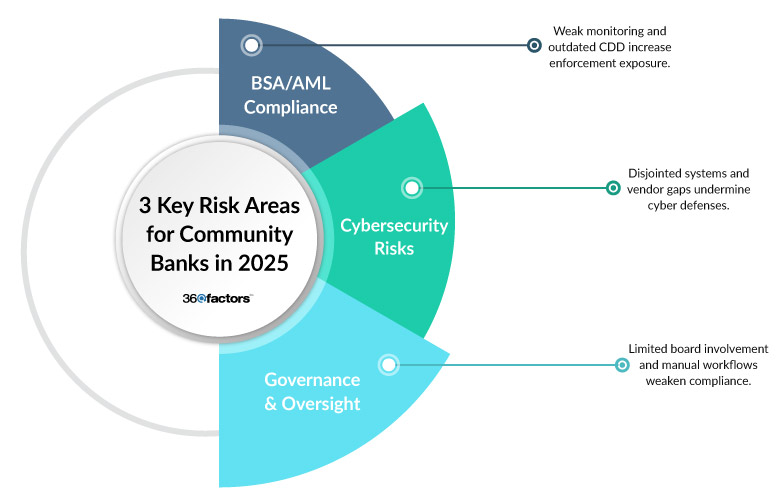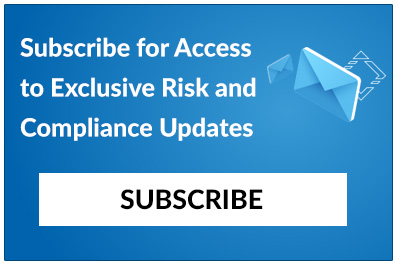Home/ Blog / Top Risks for Community Banks and Smarter Risk Management in 2025
As 2025 progresses, community banks are navigating an increasingly complex and high-pressure environment. Regulatory expectations are rising, operational risks are intensifying, and the need for sharper, more integrated community bank risk management has never been more urgent. New leadership at key regulatory agencies is shaping policy priorities with a renewed focus on enforcement, particularly in areas where oversight programs are fragmented or outdated.
For small banks, the challenge is compounded by resource constraints and legacy processes that struggle to keep up with modern risks. From rising incidents of financial crime to the growing sophistication of cyberattacks, gaps in compliance, governance, and response readiness can quickly escalate into regulatory violations or reputational damage.
Three areas stand out as critical in 2025:
- BSA/AML compliance, where ineffective monitoring and outdated customer due diligence leave banks exposed to enforcement risk.
- Cybersecurity and incident response, where fragmented frameworks and third-party dependencies create operational vulnerabilities.
- Governance and board accountability, where weak internal controls and limited program oversight undermine compliance integrity.
To stay ahead, small institutions must take a proactive, technology-enabled approach to community bank risk management, replacing reactive practices with streamlined processes, clearer visibility, and greater board engagement.
Three High-Impact Risk Themes for Community Banks
Below, we explore the three risk areas most critical for community banks in 2025:

1. BSA/AML Compliance and Financial Crimes Oversight
The regulatory focus on financial crimes is intensifying, and community banks are under pressure to strengthen their BSA/AML frameworks. Compliance examiners target small business banking institutions where monitoring might be inconsistent, escalation processes are unclear, or risk assessments lack structure. In many cases, the problem is not awareness but execution. Community banks may know what’s required of them, but with limited resources, legacy tools, and fragmented processes, they have several gaps that are difficult to close.
One of the most common risks involves monitoring suspicious activity. Inadequate protocols for detecting and escalating suspicious activity reports (SARs) can delay action and attract regulatory penalties. Compounding the issue is inconsistent training among frontline staff, who are often the first line of defense but may lack clear guidance on identifying and reporting red flags.
Customer due diligence (CDD) is another area of risk. Banks that rely on static, outdated risk-scoring models often fail to detect shifts in customer behavior that elevate financial crime risk. Without dynamic community bank risk management, adjusting risk profiles based on transaction history or behavioral changes alone becomes a box-checking exercise rather than a real-time risk filter.
Meanwhile, transaction monitoring systems are a persistent risk. Small business banks struggle with alert thresholds that are either too sensitive, creating noise and operational burden, or not sensitive enough to flag high-risk activity. A lack of proper calibration, explainability, and internal oversight can render these tools ineffective even where technology is in place. False positives, alert fatigue, and missed risks are common side effects.
Leadership oversight further complicates the issue. Examiners increasingly expect boards and executive teams to demonstrate active engagement in BSA/AML compliance. That includes documented training, policy review, and risk monitoring at the governance level.
To address these gaps, banks are turning to purpose-built frameworks that provide standardized BSA/AML risk assessments, embedded controls, and automated issue tracking. Real-time dashboards can identify emerging risks. As part of a more modern community bank risk management approach, alerts tied to risk profile changes and suspicious transactions help institutions move beyond static monitoring, while structured oversight tools ensure compliance is managed from the top down.
2. Cybersecurity and Operational Concerns
Cybersecurity has evolved from a technical challenge into a core business risk. Community banks face mounting pressure to meet evolving cybersecurity regulations while safeguarding sensitive customer data and ensuring operational continuity. Unfortunately, many small banks still rely on fragmented cybersecurity programs that lack end-to-end visibility, accountability, or coordination across departments.
A common risk is the absence of a unified cybersecurity framework. Without a comprehensive strategy, banks often patch together tools and policies, creating coverage gaps that bad actors can exploit. This fragmented approach makes it challenging to monitor evolving risks, enforce controls, or evaluate risk posture across IT systems and third-party connections.
Lack of incident response planning is another risk. Institutions with outdated or incomplete response plans are more vulnerable when a breach occurs. Without role-specific escalation paths or documentation templates, even minor incidents can escalate into major events, impacting customer trust and regulatory standing.
Third-party vendor risk is also on the rise. As community banks increasingly rely on external service providers for core functions, they must ensure these vendors meet minimum cybersecurity standards. Unfortunately, oversight of third-party security protocols is often limited or reactive.
To strengthen cybersecurity, community banks must adopt solutions with prebuilt InfoSec assessments and role-based dashboards that align IT and audit teams on threat response. Integrated templates streamline planning, while centralized visibility is key to effective community bank risk management and enables real-time tracking and rapid escalation of cyber risks.
3. Governance, Compliance Management & Board Oversight
Strong governance is the foundation of sustainable compliance, but many small business banks remain exposed due to gaps in governance practices. Regulatory agencies are increasing expectations for board engagement, program documentation, and internal control testing. Compliance programs that rely on outdated policies, manual workflows, or scattered data sources struggle to keep up.
A key risk is the lack of formalized board involvement. Regulators expect boards to understand compliance responsibilities, participate in risk discussions, and proactively monitor risk indicators. When engagement is reactive or superficial, institutions may miss critical risks or fail to demonstrate oversight during an exam.
Manual risk management also continues to hamper governance teams. Without centralized tools to manage tasks, policies, and deadlines, even well-intentioned programs become error-prone. Gaps in documentation, inconsistent internal controls, and missed review cycles are common outcomes.
Internal control testing and regulatory alignment are equally important. Institutions must regularly assess control effectiveness and ensure that policies address all relevant regulatory areas. Missing coverage not only increases risk but also creates compliance gaps.
Community banks can centralize compliance through platforms that standardize controls, store audit-ready documentation, and support real-time board reporting. As part of effective community bank risk management, these tools offer Information Security, using AI to spot control gaps and remediate them.
Strengthening Risk Management Frameworks for 2025 with Technology
The risk themes outlined in BSA/AML oversight, cybersecurity readiness, and governance effectiveness underscore a critical need: community banks must move beyond manual, reactive approaches and embrace more innovative, integrated risk frameworks. In 2025, success depends on automating community bank risk management, leveraging AI for informed risk decisions, and gaining unified visibility across all risk domains.
Rather than relying on spreadsheets, scattered documentation, or isolated teams, the best small business banks use technology to unify risk data, standardized assessments, and centralized oversight. AI-powered tools can identify control gaps, flag emerging risks, and reveal actionable insights, enabling risk teams and leadership to respond with clarity and speed.
Predict360 Essentials: The Right-Sized Risk Management Platform for Community Banks
For community banks navigating today’s rising regulatory pressure and resource limitations, the challenge isn’t just identifying risks, it’s managing them effectively without adding headcount or outsourcing vital functions. That’s where a right-sized, purpose-built platform becomes essential.
Designed specifically for U.S. community banks and credit unions with under $3 billion in assets, Predict360 Essentials streamlines community bank risk management with preconfigured, standardized risk libraries across domains like BSA/AML and cybersecurity. The platform simplifies complex workflows through real-time issue tracking, board-ready dashboards, and centralized documentation, empowering teams to act with greater speed and precision. With assistance from Kaia, its native AI companion, institutions gain contextual insights, control gap analysis, and detailed recommendations all within a single, scalable, and easy-to-deploy solution.
Request a Demo
Complete the form below and our business team will be in touch to schedule a product demo.
By clicking ‘SUBMIT’ you agree to our Privacy Policy.



